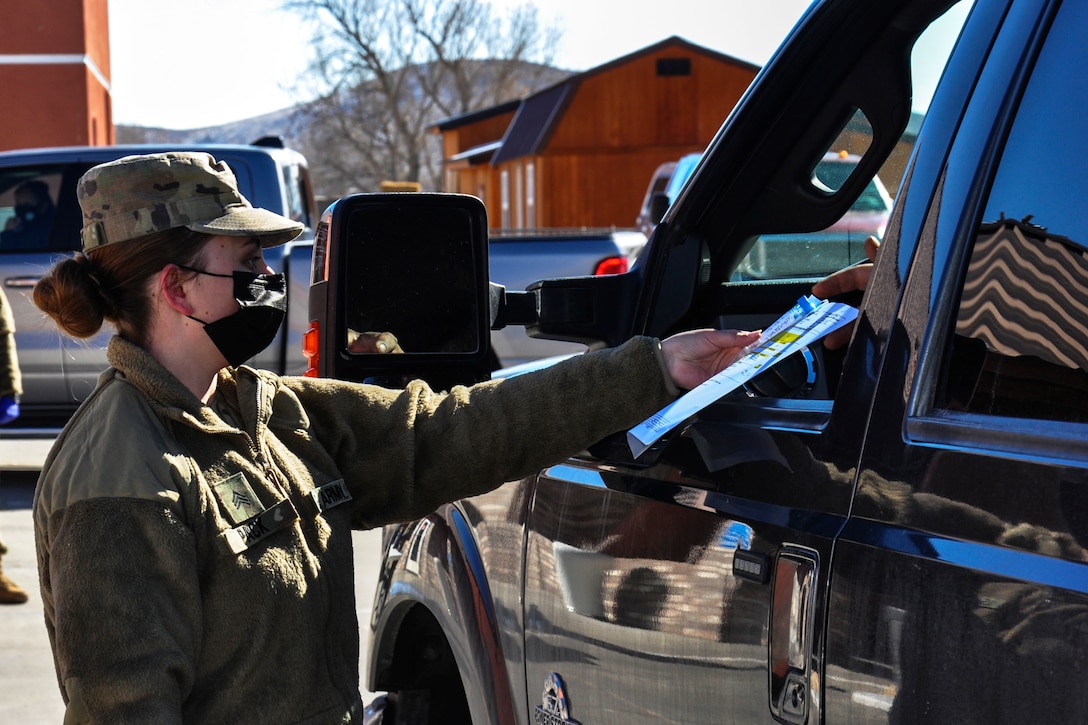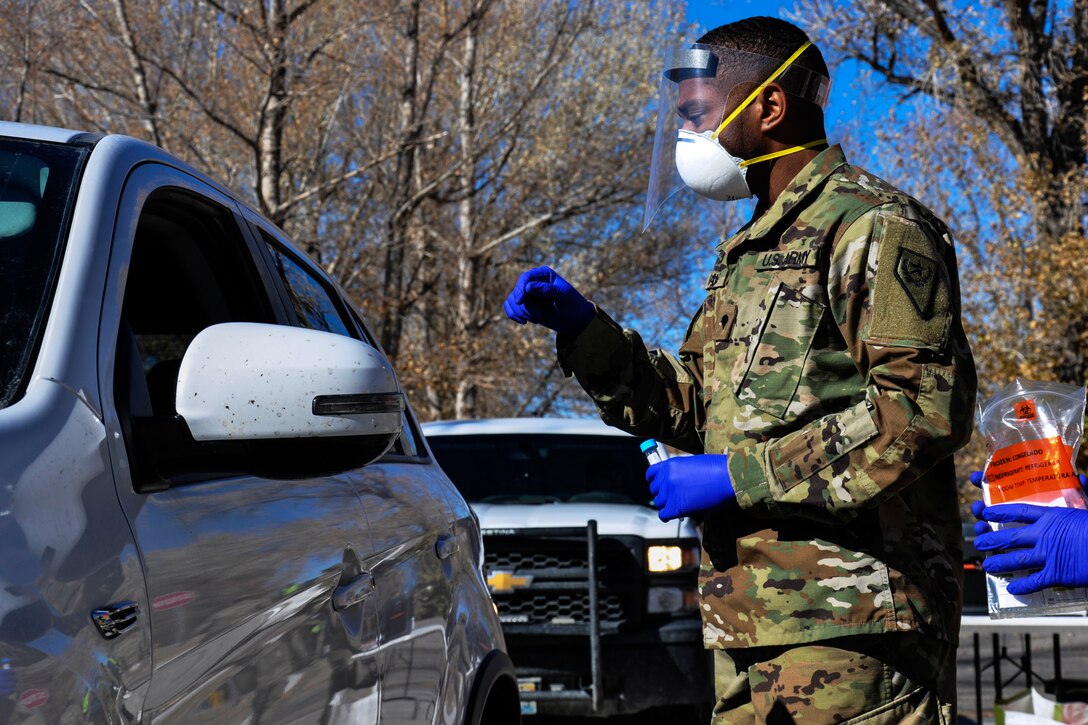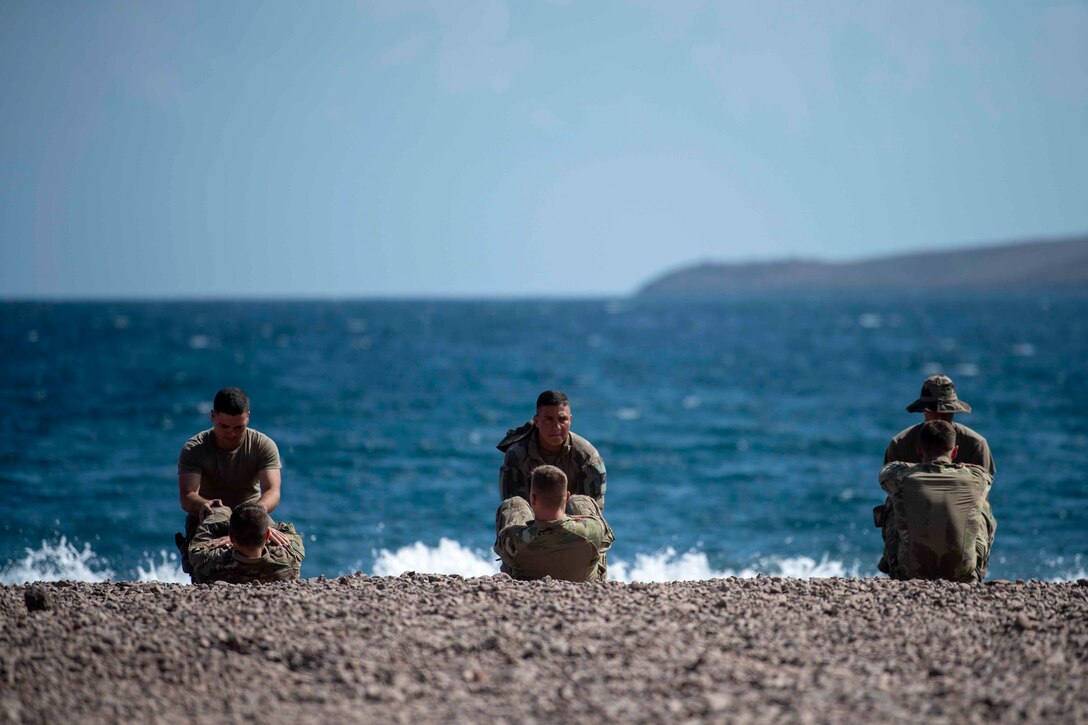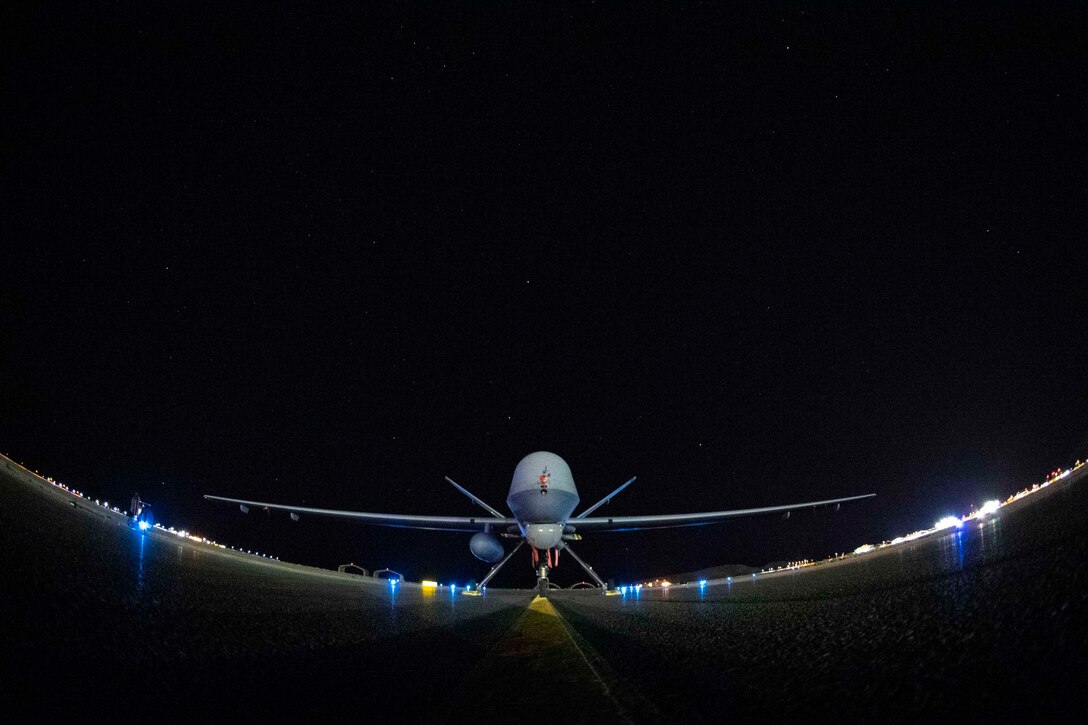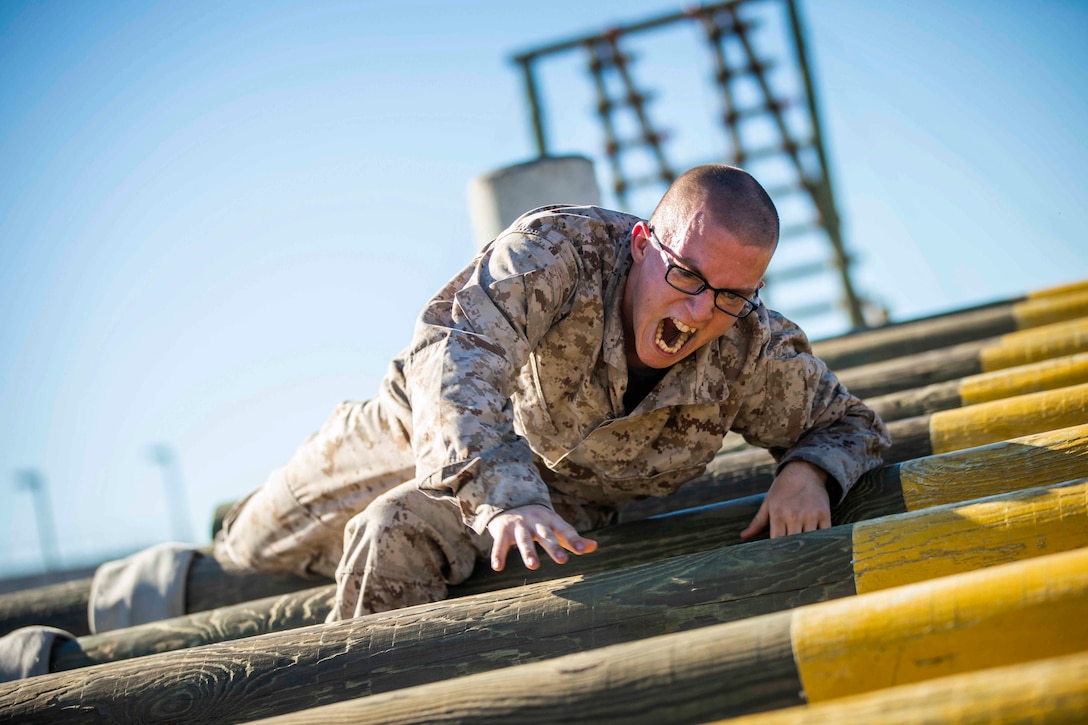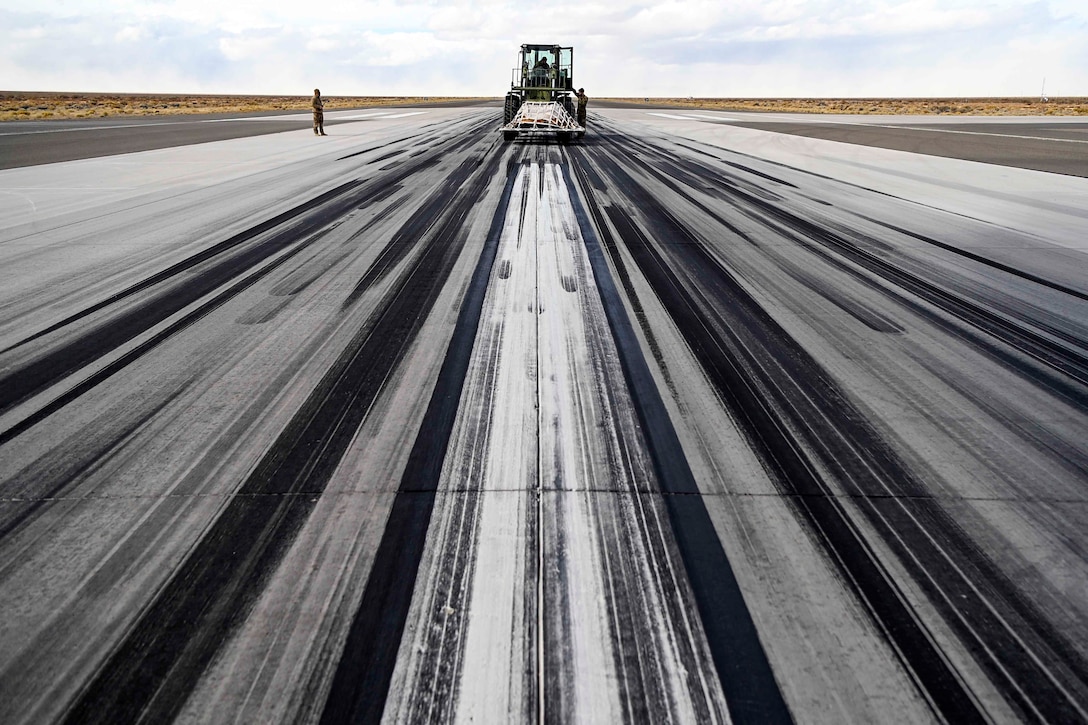Army Sgt. Alexis Pack prepares paperwork for a COVID-19, community-based collection site in Duckwater, Nev., Nov. 10, 2020. Pack works with Task Force South’s coronavirus strike team and assisted the Shoshone Tribal Health Clinic while testing over 70 members of the tribal community
Wednesday, November 18, 2020
Sample Collection
Army Spc. Keith Davis assists patients with nasal swab samples for the COVID-19, community-based collection site in Duckwater, Nev., Nov. 10, 2020. Davis works with Task Force South’s coronavirus strike team and assisted the Shoshone Tribal Health Clinic while testing over 70 members of the tribal community.
Confidence Course
Marine Corps Recruit Taryn Bunton navigates an obstacle as part of a confidence course at Marine Corps Recruit Depot San Diego, Nov. 16, 2020.
Acting SECDEF Announces OSD Changes at Fort Bragg, NC
Nov. 18, 2020
ANNOUNCER: Good morning, acting Secretary Miller and distinguished guests. We are gathered today for a signing ceremony to implement the reforms outlined in Section 922 of the fiscal year 2017 National Defense Authorization Act.
For nearly four years, the Department of Defense has planned and prepared to implement this important legislation. It not only strengthens the role of the assistant secretary of defense for special operations and low-intensity conflict as a senior civilian for special operations within the department, but it also reinforces the partnership with the commander of the United States Special Operations Command.
Ladies and gentlemen, we will have opening remarks from the acting undersecretary of defense for intelligence and security, Mr. Ezra Cohen.
ACTING UNDER SECRETARY OF DEFENSE EZRA COHEN-WATNICK: Thank you, Jim.
Mr. Secretary, on behalf of the men and women of U.S. Special Operations, especially Army Special Operations, welcome home. We are honored that you have returned to your roots on this historic day on hallowed ground.
Today, the Department of Defense has started the process of formalizing what we have long known – the fundamental role of U.S. Special Operations in defense and foreign policy by elevating Special Operations forces to a level on par with military departments as authorized and directed by Congress.
As we enact these reforms, we follow the vision of President John F. Kennedy, who predicted the rise of Special Operations nearly 60 years ago. He foresaw, quote, "another type of war, new in its intensity, ancient in its origin, that would require a whole new kind of strategy, a wholly different kind of force, forces which are too unconventional to be called conventional forces, which are growing in number and importance and significance."
President Kennedy gave these remarks at the opening of the nuclear age, when the Pentagon was primarily organized to plan and direct large conventional operations against superpowers, not special operations short of overt declared conflict. The global demand for Special Operations forces then and now has confirmed President Kennedy's foresight. And now, under the leadership of President Trump, we are fully realizing President Kennedy's prescient view of Special Operations forces.
It is fitting that we are again entering an era of great power competition as we gather to affir -- affirm the importance of special -- the Special Operations community. Then, as now, I know Special Operations forces will play a vital role, and by the historic reforms we have enacted today, we will ensure Special Operations forces has a civilian advocate commensurate to the secretaries of the other military departments. I am honored to serve as your service secretary. Thank you very much.
(APPLAUSE)
ANNOUNCER: Ladies and gentlemen, acting Secretary Miller. (inaudible).
ACTING SECRETARY OF DEFENSE CHRISTOPHER C. MILLER: Here, Jim, you take this. Got my big book; going to speak for a couple hours.
Good morning, everyone. Wow, what a week. That old cliché, if you want a friend in Washington, D.C., get a dog may be true for many. But for me, I know I can come to Fort Bragg and be with my brothers and sisters in Special Operations forces, who will always have my back.
It is an honor to be here on this hallowed plaza, where we are reminded of the enormous sacrifices and burdens shouldered by our nation's special operators. These brave heroes were first to the enemy's doorstep, Mark, in the aftermath of the September 11th attacks in 2001. Only weeks after that dark day in our nation's history, they plunged into danger to bring justice to the terrorists who took thousands of innocent American lives, and they will be the ones who continue to deny safe haven to violent extremists and maintain unrelenting pressure on the road to stability and lasting peace in Afghanistan and Iraq.
I know firsthand the caliber and character of these brave service members, being served -- having served as an Army Special Forces company commander under then-Colonel John Mulholland during Operation Enduring Freedom -- and with Mark, of course. I also served two tours in Iraq, including during the 2003 invasion, and later, in 2006 as a Special Forces battalion commander, 2nd Battalion, the Special Forces group -- absolutely the best Special Forces battalions in the history of the world -- no offense. I spent the remainder of my career just as committed to defeating terrorists and those that would help harbor them.
Today, we are gathered before a monument that symbolizes the tremendous cost of these conflicts and our relentless vigilance. In light of the countless sacrifices made by hundreds of thousands of American service members and our enormous progress over nor -- over nearly two decades, we are now bringing these conflicts to their successful and responsible conclusion under the bold leadership of President Trump.
Yesterday, the president ordered the downsizing of our force presence in Afghanistan and Iraq: 2,500 troops in each country by 15 January 2021 in a manner that protects our fighting men and women and our hard-earned gains. At the same time -- you all know this -- should any malign actors underestimate our resolve or attempt to undermine our efforts, we will not hesitate to restore deterrence and defeat any and all threats.
As we implement the president's orders, we also recognize that transitions and campaigns are fraught with risk and unexpected challenges and opportunities. That is why I am here today to announce this -- this is an omen -- uh oh. I'm here today to announce that I directed the Special Operations civilian leadership to report directly to me instead of through the current bureaucratic channels. This historic step finalizes what Congress has authorized and directed, and will put Special Operations Command on par with the military services for the first time.
This reform will immediately improve agility to the department and the command, and will enable us to streamline information flow, enhance decision-making and more adaptively and adeptly support our commanders and their superb soldiers, sailors, airmen and Marines. Change is often tectonic in the Department of Defense. This is by -- this is by design, and as our history shows, has served the nation very well.
Today's reforms is directly aligned with all three of my priorities, as outlined in my message to the force on Monday. First, bring the current war to an end in a responsible manner that guarantees the security of our citizens; two, continue implementing the National Defense Strategy with an emphasis on transforming the department for great power competition; and three, accelerate the department's activities to contribute to our whole-of-government effort to combat transnational threats.
I also want to highlight that this particular change has been analyzed, debated and refined over the course of the past 30 years, since the creation of Special Operations Command and the assistant -- and the creation of the assistant secretary of defense for special operations, low intensity conflict by the Nunn-Cohan -- Cohen, excuse me -- Nunn-Cohen Amendment to the Goldwater-Nichols Act of 1987. I have closely studied and been intimately involved in these efforts. I personally think SOLIC deserves to be an undersecretary of defense, but unfortunately, that's beyond my authority and purview at this time, but I know future generations will take that one on.
Today, as we chart a clear path forward for our special operators, we proudly stand on the shoulders of the giants who came before us: Colonel Aaron Bank, founder of the U.S. Army Special Forces; Major Richard "Dick" Meadows of the U.S. Army Special Forces, who is mortalized in the statue nearby; Major General Johnny Alison, founder, U.S. Air Force Special Operations; Captain Phil Bucklew, whose name adorns the Naval Special Warfare Center in Coronado, California; Brigadier General Evans Carlson. Where are the Devil Dogs? What an incredible commander, an influential commander of the earliest Marine Raiders; Major General Jack Singlaub, a trailblazer amongst Special Operations forces; former acting -- sorry -- former Army Secretary John Marsh, a vocal advocate for SOF improvements in the wake of Operation EAGLE CLAW; and more recently, Colonel retired Dave Maxwell, United States Army Special Forces; Lieutenant Generals John Mulholland and Charles Cleveland. Is that -- Charles Cleveland. He's always Charlie Cleveland. That's good to see it formalized there. They're now retired senior leaders in the Special Operations community.
We also acknowledge the leaders in Congress who were a driving force behind the Nunn-Cohen reorganization. I'm reminded of the late Congressman Dan Daniel from Virginia, early and influential proponent of Special Operations reform; and Jim Locher, who was instrumental in garnering bipartisan support for the reorganization, and later became the assistant secretary of defense for Special Operations Low-Intensity Conflict. We have to remember though, behind these titans stood an enormous group of dedicated patriots, many that have served in this building, who did the heavy lifting to create what ultimately became U.S. Special Operations Command, a national treasure, unparalleled in the world. These patriots give us strength, and remain our guiding lights.
Today, with the strong support of President Trump, we are forging the next chapter in the history of the United States Special Operations Forces in formalizing a watershed reform. Right now we start the transition to provide greater civilian oversight of -- and critical advocacy for our special operators.
This couldn't come at a more critical moment in time as we bring our nation's longest conflict to a responsible end and prepare our Special Operations forces for this new era of great power competition. I can think of no better place than here, at the original home of our Special Operations forces, to enshrine stronger support for the next generation of special operators, hardened by combat and unrelenting deployments, who understand the fundamental nature of war, who remain committed to defeating every threat, and who are undeterred by the high-price of victory.
De oppresso liber. God bless our women and men in uniform. God bless our great nation. Thank you so much.
(APPLAUSE)
ANNOUNCER: Ladies and gentlemen, joining acting Secretary Miller for the signing of the document is Mr. Mark Mitchell, the former acting assistant secretary of defense for special operations low-intensity conflict, Mr. Cohen and Dr. Joseph Tonon.
(CROSSTALK)
ANNOUNCER: And Colonel (retired) Dave Maxwell.
(CROSSTALK)
(APPLAUSE)
ANNOUNCER: Ladies and gentlemen, thank you for attending today's events. This concludes the ceremony.
Statement From Acting Secretary of Defense Christopher C. Miller on UK Announcement of Largest Military Investment in 30 Years
Nov. 18, 2020
“The US Department of Defense applauds the announcement by the United Kingdom to significantly increase defense spending. The UK is our most stalwart and capable ally, and this increase in spending is indicative of their commitment to NATO and our shared security. With this increase, the UK military will continue to be one of the finest fighting forces in the world. Their commitment to increased defense funding should be a message to all free nations that the most capable among us can – and must - do more to counter emerging threats to our shared freedoms and security.”
Transport Lines
Airmen use an all-terrain forklift to transport cargo to a C-17 Globemaster III at Amedee Army Airfield in Herlong, Calif., Nov. 6, 2020.
DOD Prioritizes December Launch of 'Trusted Capital Marketplace'
Nov. 18, 2020 | BY C. Todd Lopez , DOD News
While plans are underway for a change in administration, officials within the Defense Department still have several goals they'd like to achieve. Among those is implementation of the "Trusted Capital Marketplace," the undersecretary of defense for acquisition and sustainment said.
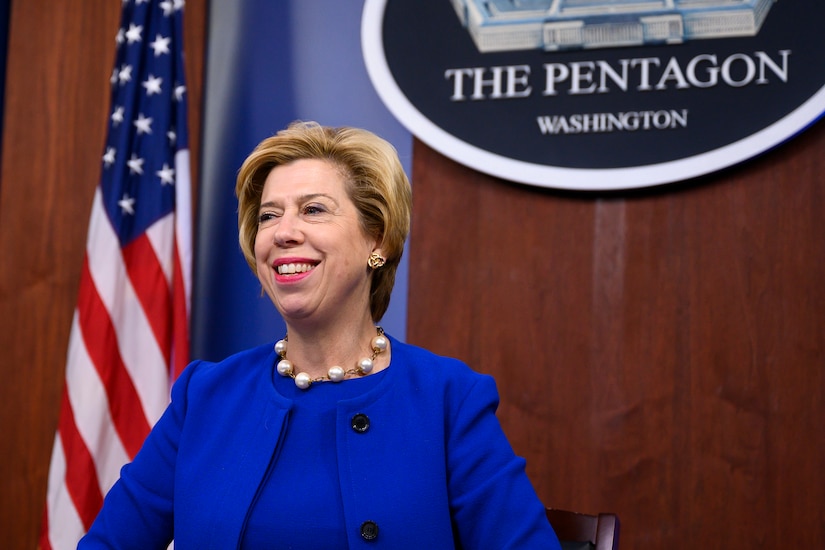
"[One] area that we want to bring over the finish line here is our trusted capital project," Ellen Lord said during an online discussion today as part of the three-day American Institute of Aeronautics and Astronautics ASCEND Summit. "We'd like to think the capital markets are very, very efficient. But we work with the Council on Foreign Investment in the U.S. to block or undo a lot of transactions where our adversaries are coming in and buying companies that are critical for our national technology initiatives."
The Trusted Capital Marketplace project is a department effort within A&S meant to both support the defense industrial base and limit adversary nation access to American technology. The effort is in response to a mandate by Congress laid out in the 2018 National Defense Authorization Act.
Within the Trusted Capital Marketplace, the department will be involved in matching up businesses in need of investment with investors that have been shown to not have ties to adversarial nations.
"What we want to do is instead of driving companies, or driving people trying to sell real estate to these adversarial and nefarious kinds of actors out there, we want to be able to partner people with clean money with companies where we understand the beneficial ownership and grow that capability for the betterment of our national security and economic security," Lord said.
To facilitate that, there's going to be an electronic marketplace, she said, something she said pairs up cleared investors and companies in need of investment in much the same way a dating website might work.
"What we're doing is clearing people with money, investors, and then companies that have critical technology for the Department of Defense, and giving them a place where they can get together and talk and hopefully do some deals," she said.
Lord said she expects the Trusted Capital Marketplace to be available in December.
"We are literally just going through federal paperwork right now to launch this," she said. "I'm really excited about our Trusted Capital Marketplace."
U.S. Donates Field Hospital to South Africa for COVID-19 Response
Nov. 18, 2020 | BY Army Lt. Col. Al Phillips , New York National Guard
The hospital was purchased by U.S. Africa Command through the command's Humanitarian Assistance Program, and transferred to South African officials by personnel from the U.S. Embassy in Pretoria, South Africa.
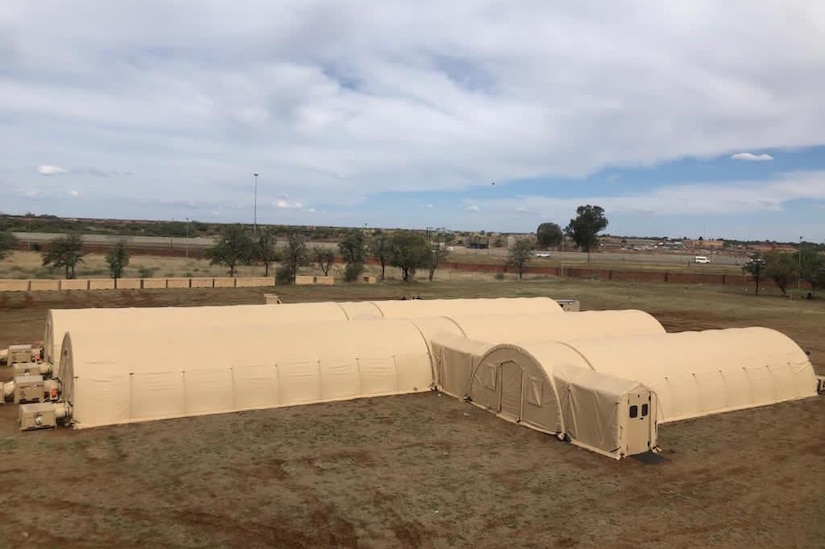
Mahikeng, previously known as Mafikeng, was chosen as the location for the hospital by Dr. Zweli Mkhize, South Africa's health minister, because of an increase in COVID-19 cases in the province in recent weeks.
"The donation of this field hospital is timely given that our scientists are anticipating a possible second wave of COVID-19 infections in February," Jeanette R. Hunter, the deputy director general for primary health care at the South African National Department of Health, said.
As of Nov. 5, 2020, the Mahikeng Provincial Hospital had only four negative pressure isolation beds to treat 28 COVID-19 patients.
Negative pressure beds are maintained in rooms isolated from the rest of a facility. The air pressure inside these rooms is maintained at a lower level. This keeps air — which could be contaminated — from flowing out when a door is opened.
In order to ensure there were enough beds to treat COVID-19 patients, 90 beds that were used for other purposes were shifted to accommodate. This restricted the hospital's ability to treat patients without COVID-19, Hunter said.
The new field hospital has 40 beds isolated by negative pressure, which will increase the hospital's capacity for more patients.
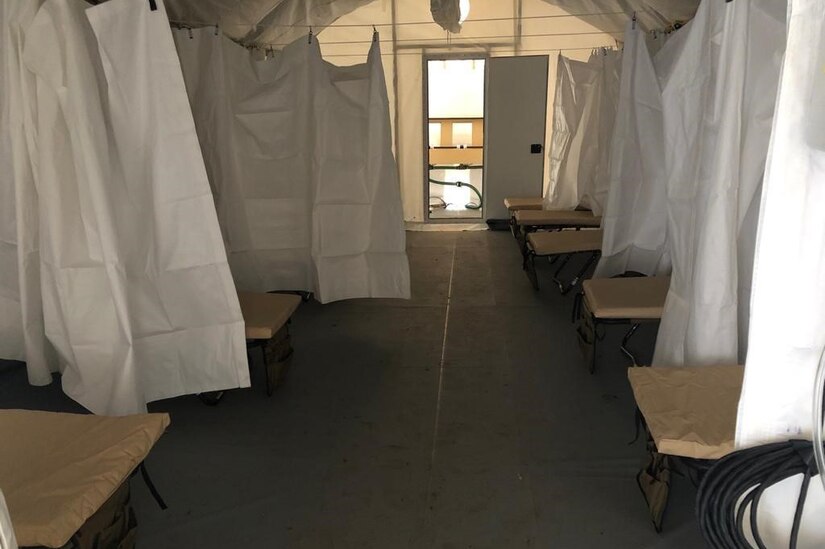
The hospital was manufactured by Alaska Structures, an Anchorage company that specializes in engineering fabric buildings. Two 2,300 kilowatt generators provide power, and the system includes toilets, showers and a limited reception area.
The hospital can operate autonomously and is equipped with eight air conditioning units equipped with high efficiency particulate air filtration and ultraviolet light scrubber systems to control infections.
"The fight against COVID-19 in South Africa is not over, and that's why this state-of-the-art field hospital donation from the American people, through Africom, is especially timely," U.S. Ambassador Lana J. Marks said.
"We once again commend the South African government and Minister Mkhize, who personally chose Mahikeng as the location for this facility, on their response to the pandemic, which the United States government has been honored to support," Marks added.
The field hospital was set up during the latter portion of October and transferred to the South African government during a ribbon-cutting ceremony on Oct. 26.
Africom sent a team of civilian trainers to assist South African medical and support teams selected to run the mobile hospital on its assembly, set up, facilitation, transportation and storage.
Africom's support to the COVID-19 response and mitigation efforts began in late March, early April, as the first signs of COVID-19 infections emerged.
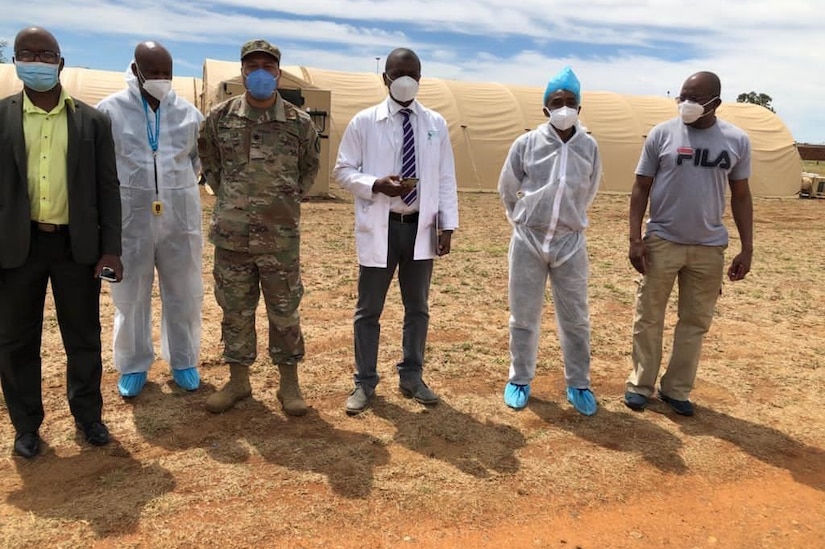
Africom has purchased seven 40-bed and seven 30-bed negative pressure isolation hospitals for African partners.
The military's Humanitarian Assistance Program, or HAP, helps partner nations build their disaster readiness, response and mitigation capabilities. The program funds infrastructure, equipment and training to help nations prepare before disasters and crises strike, but also supports countries who request assistance from the U.S. government when they experience health and weather-related emergencies.
COVID-19 assistance projects are funded under HAP to support requests from partner nations for supplies and equipment needed to respond to the virus outbreak, treat infected patients and prevent additional exposure. The U.S. Department of State and U.S. Agency for International Development review the projects and concur with their proposed assistance before they are approved, according to embassy officials.
Joint Artificial Intelligence Center Has Substantially Grown To Aid The Warfighter
Nov. 18, 2020 | BY Terri Moon Cronk , DOD News
It was just two years ago when the Joint Artificial Intelligence Center was created to grab the transformative potential of artificial intelligence technology for the benefit of America's national security, and it has grown substantially from humble beginnings.
Dana Deasy, the Defense Department's chief information officer, and Marine Corps Lt. Gen. Michael Groen, the director of the JAIC, virtually discussed from the Pentagon the growth and goals of JAIC at a FedTalks event during National AI Week.
''One of the things we've wanted to keep in our DNA is this idea that we want to hire a lot of diversity of thought into [JAIC],'' Deasy said, ''but yet do that in a way where that diversity of thought coalesces around a couple of really important themes.''
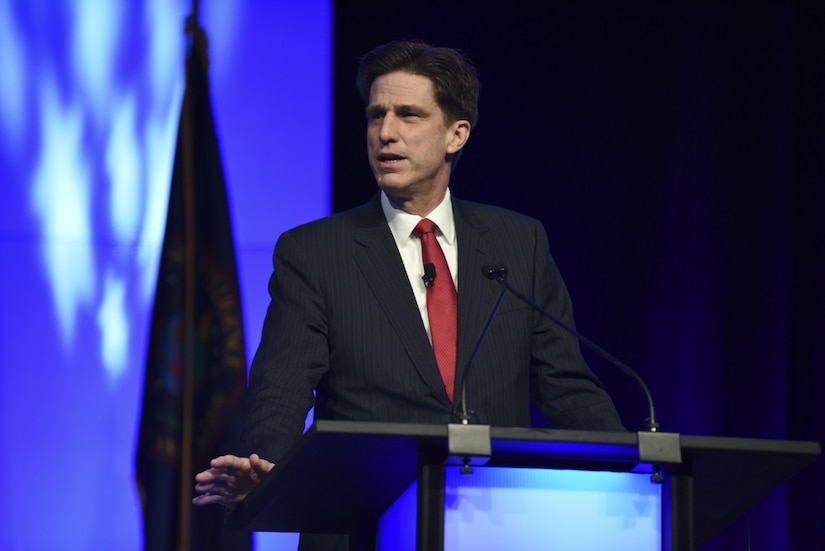
When JAIC began, it needed to grab hold of some projects that can show people that it can be nimble, agile, and it has the talent to give something that is meaningful back to the Defense Department, he noted.
So JAIC started in a variety of different places, Deasy said. ''But now as we've matured, … we really need to focus on what was the core mission … for JAIC. And that was, we have to figure out what the role is that AI plays in enabling the warfighter. And I've always said that JAIC should be central to any and all future discussions in that place,'' the CIO said.
''Transformation is our vision,'' Groen said.
''So, it's a big job. We discovered pretty quickly that seeding the environment with lots of small AI projects was not transformational in and of itself. We knew we had to do more. And so, what we're calling JAIC 2.0 is a focused transition in a couple of ways. [For example], we're going to continue to build AI products, because the talent in the JAIC is just superb,'' the JAIC director said.
Groen noted that the JAIC is thinking about solution spaces for a broad base of customers, which really gets it focused.

''There are, you know, the application, and the utilization of AI across the department [that] is very uneven. We have places that are really good. And there, some of the services are just doing fantastic things. And we have some places, large-scale enterprises with fantastic use cases [that] really could use AI, but they don't know where to start. So, we're going to shift from a transformational perspective to start looking at that broad base of customers and enable them,'' he said.
JAIC is going to continue to work with the military services on the cutting edge of AI and AI application, especially in the integration space, where JAIC is bringing together intelligence or intelligence of maneuver, Groen said, ''The warfighting functions have superb stovepipes. But now we need to bring those stovepipes together and integrate them through AI,'' he added.
The history books of the future will say JAIC was about joint common foundation, Deasy said. ''JAIC could never do all of the AI initiatives with the Department of Defense, nor was it ever created to do that. But what we did say was that people who are going to roll up [their] sleeves, and seriously start trying to leverage AI to help the warfighter every day. … at the core of JAIC's success has got to be this joint common foundation,'' he noted.
Deasy noted that the JAIC was powerful and very real.
Into next year, he added, JAIC will have some basic services. And then it's a minimum viable product approach, where JAIC is building some basic services, a lot of native services from cloud providers, but then adding services to that.
''And where we hope to grow the technical platform is a place where people can bring their data, places where we can offer data services, data conditioning, maybe table data labeling and we can start curating data,'' Deasy projected. ''One of the things we'd really like to be able to do for the department is start cataloging and storing algorithms and data. So now we'll have an environment so we can share training data, for example, across programs.''
The modernized software foundation now gives JAIC a platform so it can build AI, Groen said, adding AI has to be a conscious application layer that's applied, leveraging the platform and the things that digital modernization provides.
''But when you think of it that way, holy cow, what a platform to operate from,'' he said.
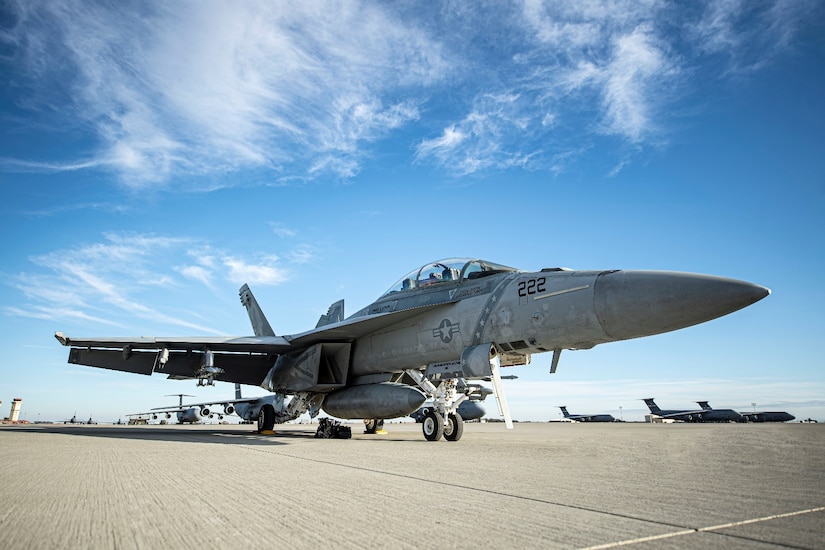
So now JAIC will really have a have a place where the joint force can effectively operate, he said, adding that the JAIC can now start integrating intel in fires, intel in a maneuver command and control, the logistics enterprise, the combat logistics enterprise and sort of the broad support enterprise, Groen noted.
''You can't do any of that without a platform, and you can't do any of that without those digital modernization tenets,'' the JAIC director said.
If JAIC is going to have the whole force operating at the speed of machines, then it has to start bringing these artificial intelligence applications together into an ecosystem, Groen said, noting that it has to be a trusted ecosystem, meaning "we actually have to know, if we're going to bring data into a capability, we have to know that's good data."
''So how do we build an ecosystem so that we can know the provenance of data, and we can ensure that the algorithms are tested to set in a satisfactory way that we can comfortably and safely integrate data and decision making across warfighting functions,'' the JAIC director asked. ''That's the kind of stuff that I think it's really exciting, because that's the real transformation that we're after.''
